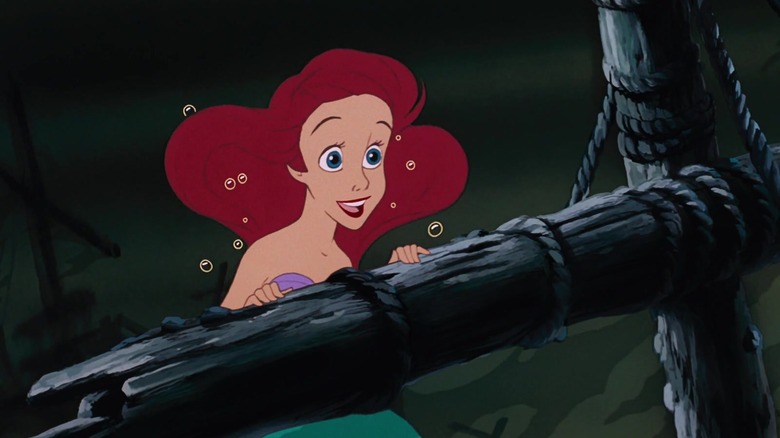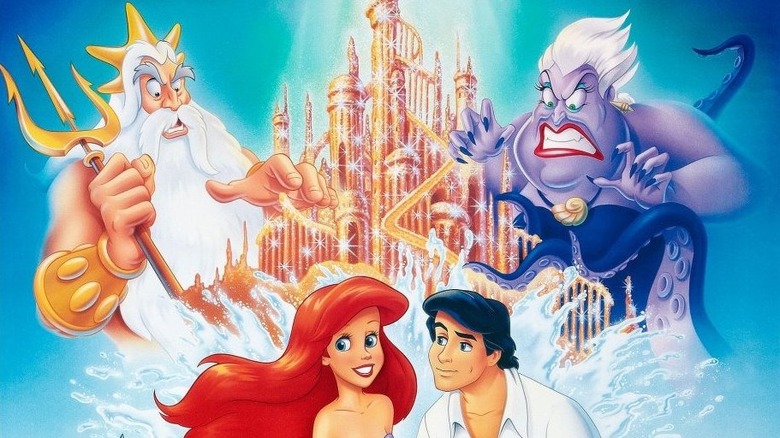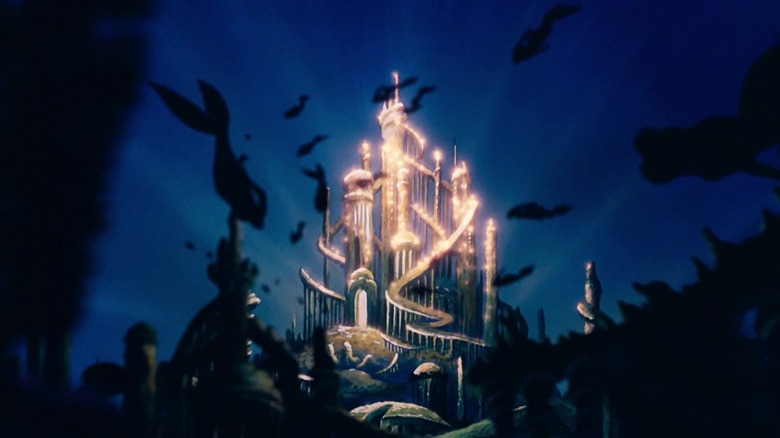The Little Mermaid's Explicit Banned 1990 VHS Cover Explained
John Musker and Roger Clements' 1989 animated hit "The Little Mermaid" premiered on VHS on May 18, 1990, only six months after the movie was released in theaters. At the time, this was considered a quick turnaround, as some films could take a full year between their theatrical runs and their home media rollouts. The VHS release of "The Little Mermaid" was also a coup in that it was one of the few films Disney had deigned to make available on the home video market. For many years, the Mouse House was very, very stingy about releasing its animated hits on VHS, allowing the company to retain a manufactured air of exclusivity. It would talk about certain movies still being "in the vault," leaving animation fans frustrated.
Hence, when "The Little Mermaid" was made available on VHS openly, many breathed a sigh of relief. Also, little kids could now watch it repeatedly, memorizing the film in perpetuity.
There was also, as many remember, something of a scandal with the film's VHS release. The cover sported an original painting (one that was also used in some of the movie's theatrical posters), which featured a large golden undersea castle surrounded by characters from the movie. It was an interpretation of King Triton's (Kenneth Mars) castle, where his daughter and the titular mermaid herself, Ariel (Jodi Benson), resided. One doesn't have to look very close to see that one of the spires in the castle happens to resemble a large erect phallus — like, uncannily so.
Because the image was on the cover of one of the nation's hottest VHSes, everyone suddenly took notice. The Phoenix New Times ran a story in 1990 about how the supermarket chain Bashas briefly pulled the video from its shelves, thinking that someone had tampered with the artwork. After it confirmed that, yes, that was the official "Little Mermaid" artwork, it restored the VHS to its stock. There was also a growing rumor that said phallus had been hidden deliberately in the "Little Mermaid" castle by a disgruntled Disney employee.
That rumor is not true.
The phallic structure in the Little Mermaid castle
As one can see in the image above, the central pillar is indeed ... suggestive. (It looks like a pricey dildo one might find at their local adult toy shop.) It's so suggestive that many assumed its resemblance to a phallus was a deliberate act. Those cognizant of such things back in 1990 likely also recall the rumor that a hardworking Disney employee (and it was a woman, at least in the version of the rumor I heard) was being underpaid for her work. Hence, in an act of defiance meant to stain a children's movie with sexual imagery, she elected to paint a penis in the middle of the "Little Mermaid" castle. If her bosses didn't notice, she could, essentially, flash the world. Lo, her bosses didn't notice, and the "Little Mermaid" poster made its way out into the world.
Again, none of that is true.
Snopes, the rumor debunking website, once looked into the matter and found the artist (whom the outlet left unidentified) who had been hired to paint a lot of the tie-in materials for "The Little Mermaid," including posters, fast food meal boxes, CD covers, and the like. The artist confessed to having been under the gun and having needed to complete said artwork in the span of only a few hours. They claimed that it was about four in the morning when they turned it in to Disney. The fact that one of the castle's spires resembled a human penis was mere happenstance. It seems that they didn't even notice the penis resemblance until a kid from their church's youth group told them. (Evidently, the youth had heard the story on a talk radio show and contacted the artist to inform them.)
Of course, once everyone agreed that "The Little Mermaid" VHS cover had a wiener on it, Disney changed it. What spoilsports.
The updated castle had no phallus in The Little Mermaid
Of course, the fact that the penis castle was later altered led some fans to refer to the original as the "banned" edition. 1990-era VHS releases of "The Little Mermaid" began fetching a high price on the second-hand market as a result. Teens would buy them and treat them like contraband porn, flashing the offending "Little Mermaid" to friends in the know. One can go to eBay to this very day and find "Little Mermaid" cassettes, in the great old-fashioned clamshell cases, selling for $100 to $200.
It took until Disney's 1997 re-release of "The Little Mermaid" (an event with its own scandal) for the company to finally alter the artwork. The 1997 re-release warranted a new VHS edition, so the box was drastically different and featured all new artwork. It was released on March 31, 1998, and a generation of snickering kids became very dismayed. They no longer had a "naughty" Disney product to flaunt. That release also coincided with a 1999 DVD rollout, the film's first. The final VHS edition of "The Little Mermaid" was released in 2007, and that, too, boasted new artwork.
All of this doesn't address an additional penis-related scandal with "The Little Mermaid" either. There is a scene late in the film when the evil sea witch Ursula (Pat Carroll) has disguised herself as a human and hypnotized Ariel's boyfriend, Eric (Christopher Daniel Barnes). She arranges them to be married, so Ariel has to stop them before the ceremony can be completed. The priest at the ceremony, a tiny old geezer, says the phrase "Dearly beloved" to get the proceedings going ... and he seemingly gets an erection. This, however, is a mere quirk of the animation, and the priest is actually just bending his knees. One can see from another angle later in the scene where his legs are.
So, seekers of secret smut, I apologize. There are no hidden penises in "The Little Mermaid" or on its poster. At least, not that we've yet found.


